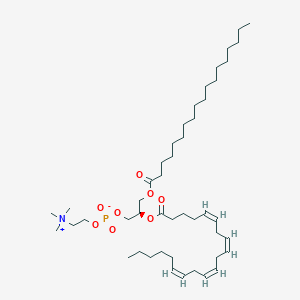| Synonyms |
Click to Show/Hide Synonyms of This Metabolite
(2R)-2-[(5Z,8Z,11Z,14Z)-Icosa-5,8,11,14-tetraenoyloxy]-3-(stearoyloxy)propyl 2-(trimethylazaniumyl)ethyl phosphate; (2R)-2-[(5Z,8Z,11Z,14Z)-Icosa-5,8,11,14-tetraenoyloxy]-3-(stearoyloxy)propyl 2-(trimethylazaniumyl)ethyl phosphoric acid; 1-C18:0-2-C20:4(Omega-6)-phosphatidylcholine; 1-Octadecanoyl-2-(5Z,8Z,11Z,14Z)-eicosatetraenoyl-sn-glycero-3-phosphocholine; 1-Octadecanoyl-2-(5Z,8Z,11Z,14Z)-icosatetraenoyl-sn-glycero-3-phosphocholine; 1-Octadecanoyl-2-(5Z,8Z,11Z,14Z-eicosatetraenoyl)-sn-glycero-3-phosphocholine; 1-Octadecanoyl-2-arachidonyl-sn-glycero-3-phosphocholine; 1-Stearoyl-2-arachidonoyl phosphatidylcholine; 1-Stearoyl-2-arachidonoyl-3-phosphorylcholine; 1-Stearoyl-2-arachidonoyl-GPC; 1-Stearoyl-2-arachidonoyl-GPC (18:0/20:4); 1-Stearoyl-2-arachidonoyl-sn-glycero-3-phosphocholine; 1-Stearoyl-2-arachidonoyl-sn-glycero-3-phosphorylcholine; 1-Stearoyl-2-arachidonoyl-sn-glycero-phosphatidylcholine; 1-Stearoyl-2-arachidonoylphosphatidylcholine; 1-Stearoyl-2-archidonyl-3-sn-phosphatidylcholine; 18:0/20:4 Phosphatidylcholine; GPC(18:0/20:4(5Z,8Z,11Z,14Z)); GPC(18:0/20:4); GPC(18:0/20:4n6); GPC(18:0/20:4w6); GPC(38:4); GPCho(18:0/20:4(5Z,8Z,11Z,14Z)); GPCho(18:0/20:4); GPCho(18:0/20:4n6); GPCho(18:0/20:4w6); GPCho(38:4); Lecithin; PC(18:0/20:4(5Z,8Z,11Z,14Z)); PC(18:0/20:4); PC(18:0/20:4W6); PC(18:0/20:4n6); PC(18:0/20:4omega6); PC(38:4); Phosphatidylcholine(18:0/20:4(5Z,8Z,11Z,14Z)); Phosphatidylcholine(18:0/20:4); Phosphatidylcholine(18:0/20:4W6); Phosphatidylcholine(18:0/20:4n6); Phosphatidylcholine(18:0/20:4omega6); Phosphatidylcholine(38:4)
|
 click to show the details of this protein
click to show the details of this protein
 click to show the details of experiment for validating this pair
click to show the details of experiment for validating this pair

